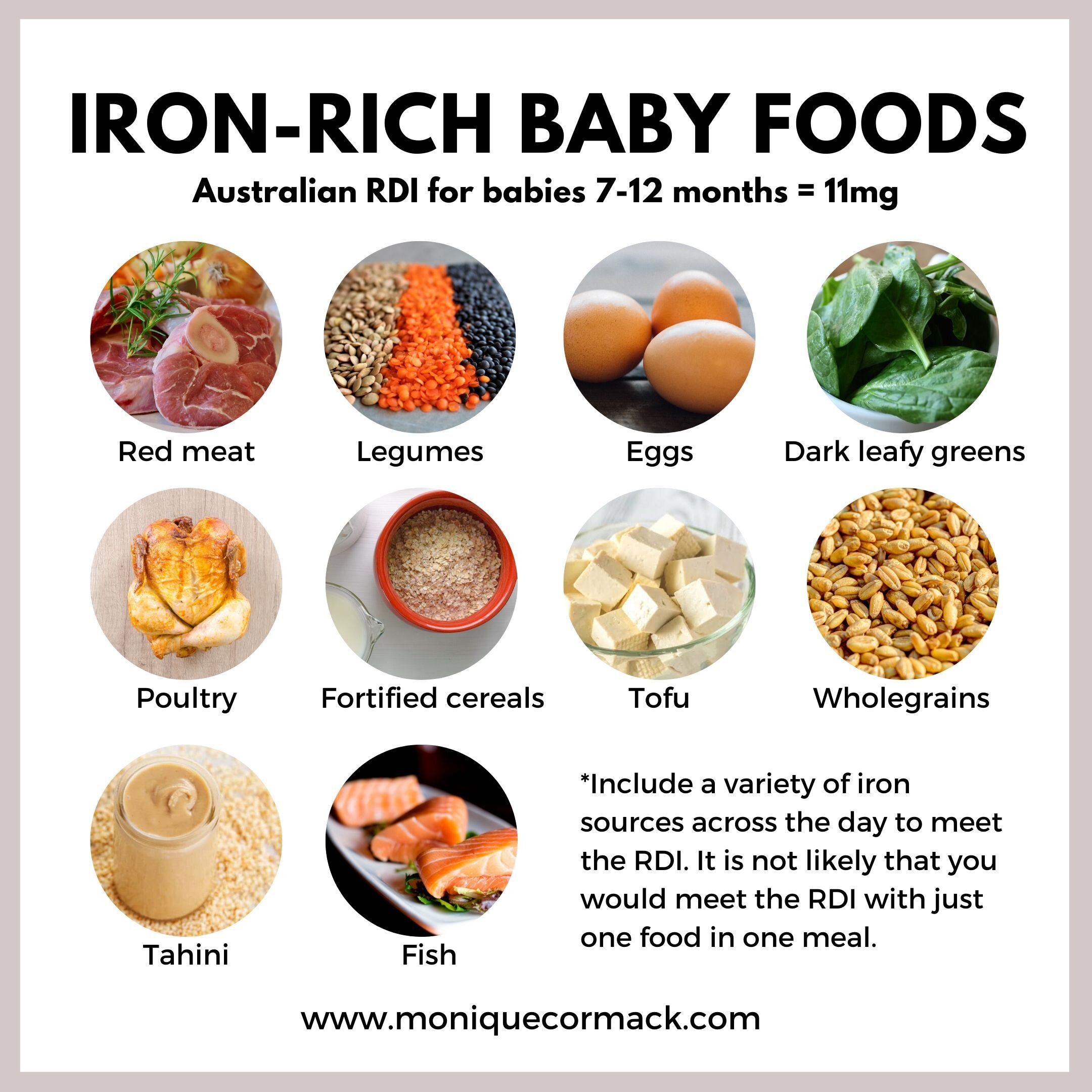Iron-Rich Foods for Babies
Though there are different approaches to introducing solids (e.g. puree v baby led weaning) one important principle that applies to whatever approach you take is that some of the first foods introduced to bub should be iron-rich foods.
Iron is essential to infant growth and development, and in particular inadequate iron intake in infanthood/childhood can lead to cognitive impairment including decreased attention and memory, and changes to social and emotional behaviour (Cerami, 2017).
Babies are born with iron stores built up during their time in the womb. This keeps them going until around six months of age, which is the usual time that complementary feeding (i.e. solids alongside milk feeds) is introduced. After six months, bub’s iron stores will be depleted and it’s time to replenish them through solid food.
Recommended intake of iron for babies
The Australian recommended dietary intake of iron for babies aged 7-12 months is 11mg. Babies aged 1-3 years old need 9mg per day.
Iron is found in a number of foods, and to meet the daily target for little ones it’s best to try to include a variety of iron-rich food sources across the day, as the recommended intake is quite high relative to the quantity of food they’re likely to eat.
Foods high in iron for babies
Try some of these iron-rich foods for baby. I’ve included some ideas for you to help plan some yummy meals.
Red meat: slow-cook meat so it’s super soft; blend it after slow-cooking so it’s in puree form if needed for young babies. Soft pieces are also pretty easy for babies to pick up with their fingers.
Legumes: there are SO many ways to serve legumes. Lentil bolognese, mashed chickpea fritters, cannellini bean mash, chickpea pasta, or even some peanut butter (as peanuts are a legume, too!).
Poultry: slow-cook like red meat or try making little meatballs or fingers with chicken mince for finger foods.
Eggs: scrambled eggs are soft and easy to eat or make an omelette or frittata for finger food. Also, try hard-boiled egg mashed with avocado.
Fish: don’t be scared to serve fish. Bake a fillet in the oven and serve soft flaked pieces or mash it in with some veggies, or make patties with fish and veg using an egg to bind together.
Dark leafy greens: so easy to use mashed (either alone or with other veggies), grated or shredded into fritters, scrambled eggs or omelettes.
Tofu: you can try tofu in sweet or savoury ways. Silken tofu can be pureed and served with fruit. It can also be “scrambled” as you would eggs. Firmer tofu can be cut into fingers and baked, or cooked into a sauce.
Tahini: stir into porridge, make hummus or simply spread on some bread.
Fortified cereals: there is an abundance of iron-fortified baby food available and while I don’t encourage over-reliance on packaged foods, using a fortified porridge for example, as part of a varied diet, may help meet iron targets.
Wholegrains: even grains that are not fortified with iron provide some iron regardless. Oats, quinoa, whole wheat and spelt are all good options.
Side note: haem vs. non-haem iron
Haem iron is the iron that is found in animal products. Non-haem iron is found in plant products. Non-haem iron is harder for our bodies to absorb; we can give it a helping hand by eating it with a food high in vitamin C to help our bodies take in the iron. Foods rich in vitamin C include citrus fruits, berries, kiwi fruit, tomatoes, papaya, capsicum, sweet potato and pumpkin.
Summary: iron-rich foods for babies
ONE. Babies are born with iron stores to take them up to around 6 months of age.
TWO. Introduce iron-rich foods early when introducing solids.
THREE. Iron deficiency in babies/toddlers can cause cognitive developmental issues.
FOUR. Good sources include meat, poultry, fish, eggs, legumes, tofu, fortified cereals, whole grains and leafy greens.
FIVE. Consume non-haem iron foods with foods high in vitamin C to increase absorption of the iron.
Reference: Cerami, C. (2017). Iron Nutriture of the Fetus, Neonate, Infant, and Child. Annals of Nutrition and Metabolism, 71(3), pp.8-14. 


